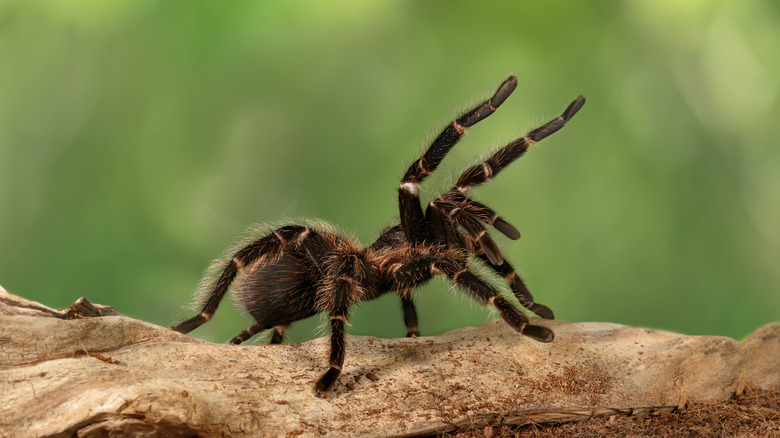The World's Oldest Spider Suffered A Gruesome Death
If you thought spiders could only live for a couple years, think again. While house spiders typically live around 1 to 7 years, other spider species can live much longer. In 2016, the oldest-known spider passed away at the age of 43 years, and its cause of death was far from peaceful. The female trapdoor spider was killed by a particularly brutal species of parasitic wasp. In the best case scenario, she was killed outright, but there's also a strong chance that the wasp had laid its eggs on the spider's body while she was still alive, leaving the eggs to hatch and eat their host.
Researchers at North Bungulla Reserve in Australia had been monitoring the spider as part of a long-term population study that was started in 1974 by Dr. Barbara York Main. Initially, the study was designed to last 20 years, but it had to be extended; to the surprise of the researchers, a female trapdoor spider named "Number 16" was still alive after the two decades were up.
Dr. York Main personally visited Number 16's burrow twice a year to record its condition. As the years ticked on, hundreds of individuals were added to the data set, yet most died within a couple of years or decades, at most. In the meantime, Dr. York Main became a big name in the field. She studied the wheatbelt region of West Australia, where the land's once-rich biodiversity has been eroding in the face of climate change and human activity. Her contributions to zoology and conservation earned her, among many other accolades, the nickname "Australia's spider woman." Sadly, Dr. York Main passed away in 2019 at the age of 90, just a few years after her star spider subject.
How one spider lived (and died) after 43 years
The expected lifespan of an organism is difficult to determine. Earth's oldest living organism is a tree (or, rather, a collective of aspen clones), while the animal with the longest lifespan — the immortal jellyfish — can theoretically live indefinitely. What is certain, however, is that few wild creatures get to enjoy the privilege of dying of old age. Environmental hazards often cut an animal's lifespan prematurely — hazards that Number 16 managed to avoid for 43 years.
Number 16 was a trapdoor spider of the species Gaius villosus. She was born at a disadvantage; only around 4% of trapdoor spiderlings survive their adolescence. Those that do reach adulthood typically live between 5 and 20 years, all the while under constant threat of predators, climate extremes, competition with fellow spiders, and habitat destruction. Males wander in search of prey and mates; females, like Number 16, enjoy the protection of their burrows.
An investigation into Number 16's cause of death was published in Pacific Conservation Biology in 2018. The researchers examined the burrow of the deceased spider, stating, "it is likely that #16 did not die of old age, but rather was parasitised by a spider wasp." Such an end is indeed gruesome. Parasitic spider wasps envenomate their victims with neurotoxins, then implant its eggs on the spider, leaving its offspring to hatch and consume the spider. The wasp larvae then takes control, potentially by injecting the spider with hormones that place it in a zombie-like state and forcing them to weave their own webby tombs to serve as a nursery for the wasp larvae. The wasp then implants its eggs on the spider, leaving its offspring to hatch and consume the spider.
Number 16 and Dr. Barbara York Main have passed on, but their contributions to understanding life's delicate balance in the shrinking Australian wilderness live on.

